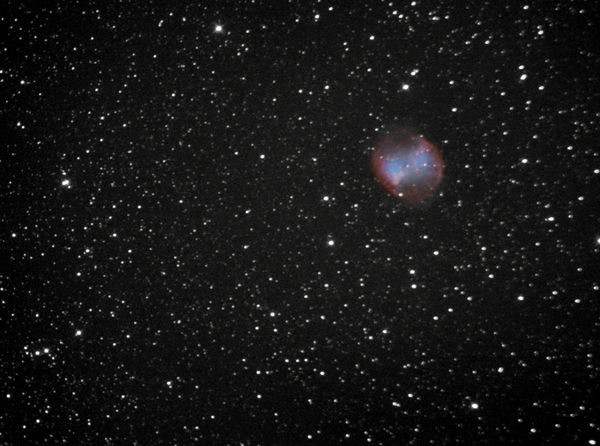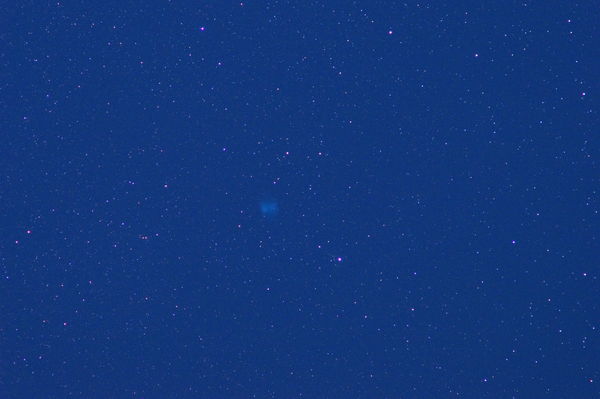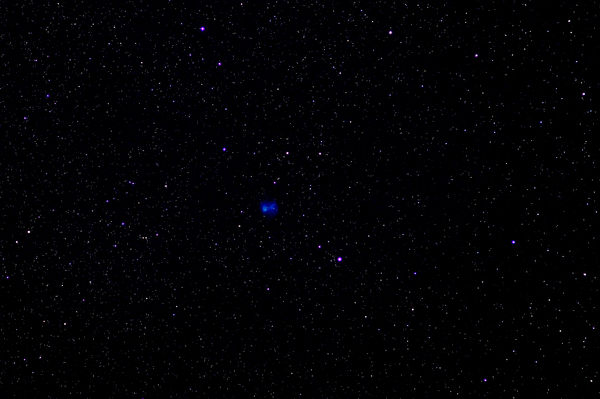Check out Street Photography section of our forum.
Messier 27/Dumbbell Nebula
Apr 9, 2015 22:09:33 #
Originally shot back in Sept, probably shot with the AT6RC. Judging by the horrible collimation this was in the test shortly after dropping the scope from the saddle when I improperly tightened it down. I am glad it was able to be recollimated, even if it was a big PITA.
Thanks for looking,
Matthew
Thanks for looking,
Matthew
Apr 10, 2015 08:43:40 #
Oknoder wrote:
Originally shot back in Sept, probably shot with the AT6RC. Judging by the horrible collimation this was in the test shortly after dropping the scope from the saddle when I improperly tightened it down. I am glad it was able to be recollimated, even if it was a big PITA.
Thanks for looking,
Matthew
Thanks for looking,
Matthew
Still a very nice pull of the Nebula.
Nice shot.
Apr 10, 2015 15:56:55 #
Oknoder wrote:
Originally shot back in Sept, probably shot with the AT6RC. Judging by the horrible collimation this was in the test shortly after dropping the scope from the saddle when I improperly tightened it down. I am glad it was able to be recollimated, even if it was a big PITA.
Thanks for looking,
Matthew
Thanks for looking,
Matthew
This posting made me look up what an AT6RC was. And I find it is a Ritchey Chretien type telescope. What's interesting about this design is that it uses a hyperbolic secondary mirror which in combination with the hyperbolic primary mirror and is supposed to correct for coma distortion.
For comparison, I am using a Newtonian type scope, the Orion 8" Astrograph. To get my stars to be pin points of light, from corner to corner, I need a coma corrector. And indeed, with the coma corrector, I get these results. Reason for the need to do this comes from the fact that the Newtonian type scope uses a flat mirror for the secondary diagonal. This means that light focused for the center has different paths to get to the edges, and the results are that all the edge stars look like their comets. And with the coma corrector, they are corrected and appear as points.
As for the Ritchey Chretien type telescope, which by the way is the design used by most professional scopes, the hyperbolic secondary mirror corrects for the problem introduced by the flat diagonal in the Newtonian Scope. I have carefully looked at your image. I see that it is not in perfect focus, but the stars near the center look the same as the stars near the edges, which is telling me that it is doing what it is supposed to do. It would be nice to see this with a perfect focus so as to completely judge how effective this scope really is.
There is also a Field Flatener available for this scope. I am not certain what improvement would come from that. And I believe that a focal reducer would also work which would effectively make the scope act like a shorter focal length lens and at the same time improve upon it's speed (for instance going from F9 to something like F6.4)
Now from what I read, the AT6RC (and AT8RC and AT10RC) are considered very reasonably priced when compared to a Schmidt-Cassegrain type telescope which are very commonly used and uses spherical mirrors, but they usually cost considerably more than the AT6RC.
Here is a Wikipedia link to the Ritchey Chretien type telescope:
http://en.wikipedia.org/wiki/Ritchey%E2%80%93Chr%C3%A9tien_telescope
And a link to the Schmidt-Cassegrain type telescope
http://en.wikipedia.org/wiki/Schmidt%E2%80%93Cassegrain_telescope
I just went back and looked at the picture again, and there is some coma distortion on the right side, particularly the upper right. I wonder if the scope was perfectly collimated? It is not as bad as my Newtonian without the coma corrector.
Apr 10, 2015 16:23:37 #
no it was not properly collimated this was a test shortly after having dropped this scope out of its saddle. I do use that ATFF22 field flattener I have not tried using a reducer yet. The only damage was to the focuser which has since been replaced.
Apr 10, 2015 17:28:15 #
Oknoder wrote:
no it was not properly collimated this was a test shortly after having dropped this scope out of its saddle. I do use that ATFF22 field flattener I have not tried using a reducer yet. The only damage was to the focuser which has since been replaced.
I would like to see what it can do when properly focused and collimated. Accordinding to the reviews, this scope outperforms scopes costing a lot more. And would like to see a with and without ATFF2.
I suppose the damage to the focuser could have left it slightly scewed to one side possibly allowing the coma on the right to appear.
Apr 10, 2015 17:55:10 #
Oknoder wrote:
Originally shot back in Sept, probably shot with the AT6RC. Judging by the horrible collimation this was in the test shortly after dropping the scope from the saddle when I improperly tightened it down. I am glad it was able to be recollimated, even if it was a big PITA.
Thanks for looking,
Matthew
Thanks for looking,
Matthew
I would think that a scope this would also deliver sharp terrestrial images. Seems like the optics should not have any distortion or chromatic aberations to contend with.
I did try my 8" Newtonian on a terrestrial view of an object about 1 mile away while using the coma corrector. The result was a very sharp image. Even sharper and better resolution than I can get from my Tamron 150-600. But it is not practical to lug around a scope this size for bird watching! The 8" mirror could certainly out resolve the smaller objective of the Tamron.
It was also way too big for my tripod. I had to balance it and camera while I took the shot. And I only took one and then immediately took it off the tripod. But that one picture sure was sharp.
Apr 10, 2015 18:22:37 #
Most of all my other pics are with the AT6RC with the exception of the last couple that were shot with my newer 70mm refractor. I will post one of Orion here in a few, but do not have comparisons with and without the field flattener. Ill try getting a couple of these tonight with a larger star field. On a side not it is a terrific scope, I got mine used for under 200 and was only looking for 5 months or so while I awaited astrotech to get a shipment of new ones. I just got lucky.
Thanks
Matthew
Thanks
Matthew
Check out Commercial and Industrial Photography section of our forum.
Apr 10, 2015 18:49:25 #
Oknoder wrote:
Originally shot back in Sept, probably shot with the AT6RC. Judging by the horrible collimation this was in the test shortly after dropping the scope from the saddle when I improperly tightened it down. I am glad it was able to be recollimated, even if it was a big PITA.
Thanks for looking,
Matthew
Thanks for looking,
Matthew
This is a great shot.
Just wondering if you did any PP to it or is it right out of the camera?
I hope you don't mind I just hit 'Auto Tone' in Lightroom. And this is what I got.
Craig
Apr 10, 2015 19:26:17 #
Oknoder wrote:
Most of all my other pics are with the AT6RC with ... (show quote)
Try posting one with just stars. Orion is quite nebulous and harder to judge how the optics are. And to make Orion look good, it takes considerable post processing. With just stars, can see how sharp the focus is and how it is from corner to corner. I did read positive reviews on this scope and I want to see if it lives up to it.
Also, what 70mm refractor did you purchase?
I took your shot, took it into Lightroom. Then sharpened it a bit and reduced the noise. Also darkened the blacks a bit.
Then took it into Photoshop where I created a Star Mask, and then went to work on the background and lowered the Blacks. Then back to Lightroom where I double checked the noise level, touch the Black level plus added a bit of clarity, and then exported.
To get a sense of the magnitudes you are recording, the bright star at the lower left of the nebula is mag 12.0. The one to the right of the lower right corner is 11.59. Beneath those two is a tiny double star pair: 15.45 and 15.6.
With Starry Night, I only need to hold the mouse over the star and it provides info on that star.
Adjusted in LR & PS
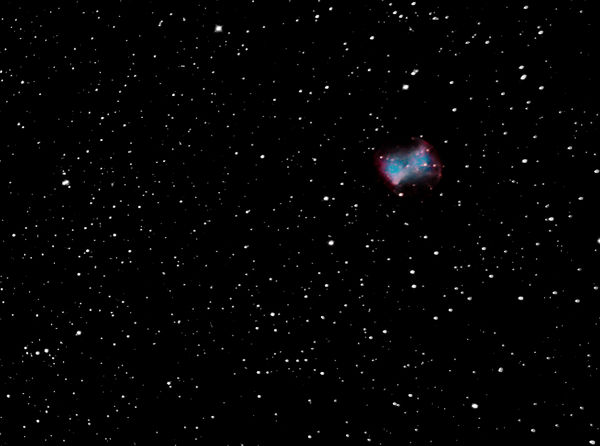
(Download)
For comparison, here is the nebula as shown in Starry Night
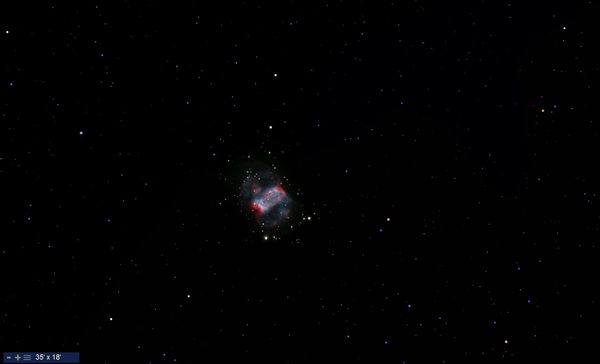
(Download)
Apr 11, 2015 11:31:18 #
CraigFair wrote:
This is a great shot.
Just wondering if you did any PP to it or is it right out of the camera?
I hope you don't mind I just hit 'Auto Tone' in Lightroom. And this is what I got.
Craig
Just wondering if you did any PP to it or is it right out of the camera?
I hope you don't mind I just hit 'Auto Tone' in Lightroom. And this is what I got.
Craig
Craig I did subtract the bias, darks and flats from this image, and off the top of my head this is a stack of 8 images of prolly 30 seconds. I did use a couple of instances of different data reject algorithms within CCDStack then combined the red, blue and green images within PScs6 but didn't really tweak anything other than shadows and highlights. I have LR5.7 but rarely use it other than its database functions.
Thanks,
Matthew
Apr 11, 2015 11:37:58 #
JimH123 wrote:
Try posting one with just stars. Orion is quite n... (show quote)
Jim,
Here is the link for the images you requested.
http://www.uglyhedgehog.com/t-299299-1.html#5041584
The 70mm I have is a William Optics Zenithstar which is an older ED doublet model not manufactured anymore, which is probably why I got it for the deal I did. It replaces my Orion 80mm short tube, only con is, since it is build to a much higher standard, it is much weightier.
Thanks,
Matthew
Check out Traditional Street and Architectural Photography section of our forum.
Apr 14, 2015 06:09:56 #
CraigFair wrote:
This is a great shot.
Just wondering if you did any PP to it or is it right out of the camera?
I hope you don't mind I just hit 'Auto Tone' in Lightroom. And this is what I got.
Craig
Just wondering if you did any PP to it or is it right out of the camera?
I hope you don't mind I just hit 'Auto Tone' in Lightroom. And this is what I got.
Craig
Here is a straight conversion from the raw to JPG. I am placing the PPed image also, for a direct comparison.
The original post image was compiled of 16 files, not 8 like stated previously.
Image info
Camera: D800e
Scope: AT6RC@Prime 1370mm/F9
Mount: Advanced VX
Exp: 30 sec
Iso: 1600
Cropped the tiff to help reduce file size.
Apr 14, 2015 08:55:26 #
Oknoder wrote:
Here is a straight conversion from the raw to JPG. I am placing the PPed image also, for a direct comparison.
The original post image was compiled of 16 files, not 8 like stated previously.
Image info
Camera: D800e
Scope: AT6RC@Prime 1370mm/F9
Mount: Advanced VX
Exp: 30 sec
Iso: 1600
Cropped the tiff to help reduce file size.
The original post image was compiled of 16 files, not 8 like stated previously.
Image info
Camera: D800e
Scope: AT6RC@Prime 1370mm/F9
Mount: Advanced VX
Exp: 30 sec
Iso: 1600
Cropped the tiff to help reduce file size.
Very nice! I am including a shot I did of the same Dumbbell Nebula last summer. This was done using a Asahi Pentax Takumar 500mm f/4.5. Its a monster sized camera lens, but works nice on the equatorial mount. I used it with a crop sensor camera so it was effectively 750mm, a little more than half your magnification. This shot was for 30 sec at ISO 1600. There were 6 shots which were stacked in camera. I didn't take RAW images that night. In comparing this lens to your 6", you have an area of Pi x 4400 mm^2 (using 70mm as the size of the secondary mirror) and this prime refractor is Pi x 3066 mm^2. So you are pulling about 1.5x more light. Your F9 vs this lens at F4.5 won't matter for stars, but will for the larger nebula. I didn't process this picture yet. But you can see that I am getting just a smudge for the nebula.
I might add that I had just disassembled the Pentax lens and had reassembled. The lens would only focus to infinity and not beyond. I changed the focus so that it went a little beyond. This allowed me room to fine tune the focus so I got the stars as tiny as possible. Prior to this, when I would look at 100% crop, the stars were too big meaning that I was not actually at best focus. I might also add that undertaking this project tested my ability to reassemble it. There were set screws that were intended to not ever be removed and I ended up buying slightly larger ones and retapping the holes. This was OK on a lens this size since the part were big. But I would want to do this on a smaller lens. It works much better now. I was also able to make if focus much smoother, so that was another plus from this effort.
Just went back and added a processed image of Dumbbell Nebula.
Apr 14, 2015 10:25:16 #
Oknoder wrote:
Here is a straight conversion from the raw to JPG. I am placing the PPed image also, for a direct comparison.
The original post image was compiled of 16 files, not 8 like stated previously.
Image info
Camera: D800e
Scope: AT6RC@Prime 1370mm/F9
Mount: Advanced VX
Exp: 30 sec
Iso: 1600
Cropped the tiff to help reduce file size.
The original post image was compiled of 16 files, not 8 like stated previously.
Image info
Camera: D800e
Scope: AT6RC@Prime 1370mm/F9
Mount: Advanced VX
Exp: 30 sec
Iso: 1600
Cropped the tiff to help reduce file size.
Wonderful job on PP Matthew.
Craig
Apr 14, 2015 10:58:14 #
JimH123 wrote:
Very nice! I am including a shot I did of the same Dumbbell Nebula last summer. This was done using a Asahi Pentax Takumar 500mm f/4.5.
Just went back and added a processed image of Dumbbell Nebula.
Just went back and added a processed image of Dumbbell Nebula.
Super image for a 500mm lens Jim, Nice work.
Craig
If you want to reply, then register here. Registration is free and your account is created instantly, so you can post right away.
Check out The Pampered Pets Corner section of our forum.





